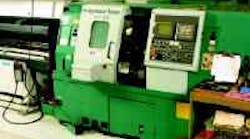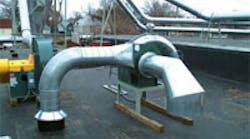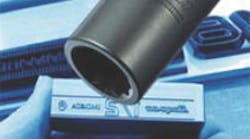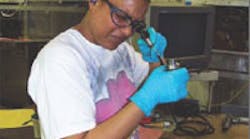Quality Plus increases its CNC turning center productivity using machinability-enhanced Project 70+ stainless steel.
Using Project 70+ premium stainless steels improves part accuracies at Quality Plus.
The Hurco VMX50 VMC's UltiMax control lets Ottenweller machinists sequence value-added steps to eliminate dead time between steps of a conventional CNC operation.
Throughspindle-coolant on the VMX50 flushes chips during heavy drilling operations at Ottenweller.
The quality-verification stations at International include Prismo CMMs and automatic part loading via overhead-gantry systems and pallet loaders.
Prismo CMMs use 18 different probe configurations and measurement programs to measure features on an engine block and cylinder head at International.
Complex molds are part of the high-and-low-volume product mix HaPeMa grinds on its JE 525 grinder.
The JE 525 grinder lets HaPeMa's operators quickly and easily set up grinding parameters.
GTI expects its recently installed Delcam software to speed and simplify data transfer for the company's sealing system and tooling designs.
A 100% polypropylene injection-molded tray from Molded Materials provides contamination-free and damage-free shipping of sprocket assemblies at INA.
FOR QUALITY PLUS PRECISION PRODUCTS in Victor, N.Y., cost savings from using commodity stainless steel machining barstock didn't improve the bottom line. Because of variations in the bargain-priced stock, the shop's machines continually needed reset, tools wore prematurely, and tolerances were inconsistent. So, the high-volume producer of precision machined parts switched to value added premium stainless called Project 70+ and has saved hundreds of thousands of dollars in manufacturing costs.
Even after discounting the higher cost of Project 70+, available from Carpenter Technology, Quality Plus CEO John Nolan estimates his company saves about 20% in real part costs yearly. Three such parts include valve stems for trucks, panel-fastener screws, and elbow components for medical gages.
Quality Plus machines valve stems from 11/2-in.-diameter Project 70+ Type 303 stock, removing more than 1 in. of material for a stem diameter of 3/8 in. As a result of upgrading to the Carpenter material, the shop increased machining speeds from 450 to 600 sfm, which boosted metal removal from 0.009 to 0.013 ipr with a 0.150-in. d.o.c. Also, tool life increased from an average of 62 parts/tool to over 100 before a tool change was needed.
Prior to using Project 70+ Type 304 stainless, Quality Plus used three 5-spindle Davenport screw machines to keep up with demand for panel-fastener screws. Now, with the new material, the shop pumps out more than the required part volume using two of the three machines, freeing up the third machine for other work.
Premature drill wear and burrs were problems when machining small elbows for medical gages until Quality Plus switched to Project 70+ Type 316 stainless. This material makes for 3 3 longer drill life, eliminates burrs and, thus, a secondary deburring operation, and improves productivity.
Carpenter Technology Corp.
WYOMISSING, PA.
cartech.com
Upgrade to VMCs streamlines production
THE OTTENWELLER CO.'S MACHINING DEPARTMENT supports the shop's main effort in sheetmetal and plate fabrication. The department has always used standard knee mills but needed something with a bit more efficiency and sophistication. Vertical machining centers provided both.
In the 1980s, the Fort Wayne, Ind., company purchased its first VMC from Hurco. One of the main selling points, according to Mike Ottenweller, owner of Ottenweller, was the machine's easy-to-use UltiMax control. It lets his machinists sequence value-added steps necessary to cut a part and reduce or eliminate dead time between steps of conventional CNC operation.
More recently, the shop purchased two Hurco VMX50 machining centers with UltiMax 4 controls. "These machines are powerful, and the coolant through the spindle improves tool life and chip flushing, especially during heavy drilling operations," says Ottenweller.
Hurco now offers its VMX50 in a CAT-50-taper-spindle version called the VMX50/50T. This new model sports a 30-hp, 8,000-rpm spindle with 300-psi through coolant as standard. The spindle motor generates 263 ft-lb of torque at 600 rpm for heavy face milling, while the spindle's high rpm permit aggressive feeds and speeds. A 163-gallon coolant tank supplies both the coolant-through-the-spindle system and the integral coolant ring at the bottom of the machine's spindle.
Like its predecessor, the VMX50/50T also incorporates highperformance Yaskawa Series II servo motors that generate 1,181-ipm rapids in X and Y and 787 ipm in Z. Table travels for X, Y, and Z measure 50 3 26 3 24 in., and the machine's 59 3 26-in. table supports loads up to 3,000 lb.
Hurco Machine Tool Products
INDIANAPOLIS
hurco.com
Quality system increases engine output
NEW V-8 DIESEL ENGINES MAKE their way through machining and assembly production lines that are nearly one mile long at International Truck and Engine Corp.'s plants in Huntsville, Ala., and Indianapolis. At each facility, the process includes multiple integrated manufacturingqualityverification stations where line operators conduct specified quality checks. To ensure accurate machining of engine crankcases, cylinder heads, and crankshafts, the two plants rely on a first-of-its-kind fully automated quality-verification system that combines CMMs with an overhead-gantry loading unit.
Verification systems at the two plants are nearly identical, except the Huntsville facility uses four automated Prismo CMMs from Carl Zeiss, while the Indianapolis plant has three Prismo CMMs. Both automated systems incorporate overhead-gantry loading from Fibro Inc. and computerized controls.
"We knew there were automated CMMs on the market that had loading systems using pallets or pick-and-place robotics, but we required one that increased throughput even further," says Donald Brown, senior manufacturing engineer at International. "The system had to automate the inspection process, optimize manpower, and provide efficient and accurate inspections on production lines," he adds.
"Single overhead-gantry units enable us to easily load parts for inspection on one CMM without disrupting the others' routines," comments Brown. "Unlike pickand-place robotics, the Fibro gantries handle larger, heavier parts."
Each CMM provides 18 probe configurations and measurement programs to verify the thousands of features on each crankcase, cylinder head, and crankshaft. Measurement time depends on process or product complexity with results for the features downloaded and sent electronically to the manufacturing line's real-time shop-floor application. So operators know when to change worn tools or make alignment adjustments.
Software programs within the CMMs include Zeiss Umess, Holos, and Strata. Umess supports true geometric tolerancing, which considers both the size and the position of holes (true position) — critical in measuring machined bores on International's parts. The software measures within 0.0002 in., uses scanned data points to produce a 3D digital image of a part, and networks with other CAD systems.
Holos software lets International analyze parts by comparing CAD data to actual scanned measurement data. It also creates CAD data from digitized measurement data without having to use other programs.
Strata software provides statistical-process control (SPC) so users can compare data to precise engineering specifications. The software gives International insights into ways to improve production for better accuracy and communicates measurement results to a real-time shop-floor SPC package.
Carl Zeiss IMT Corp.
MINNEAPOLIS
zeiss.com
Flexible grinder handles shop's ups and downs
THE NEEDS OF HAPEMA GMBH'S PRIMARY MARKETS were shifting. Throughput at the company, which makes precision-ground compound punch tooling for the automotive and electronics industries, remained high. But production runs had become a mix of shortrun, small lots interrupted by the occasional long run. It was time for a change in grinding strategy, and an off-the-shelf machine wouldn't provide it.
The shop needed a grinder that delivered both precision and reliability coupled with enough flexibility to handle high and low-volume jobs. The solution was a custom-tailored JE 525 surface and profile grinding system from K. Jung GmbH.
The machine includes a 10.4-in. color touchscreen control that displays iconographic symbology for easy programming and eliminating language barriers. Jung also combines manual and CNC dressing systems for flexibility in addressing both small and mixed lot sizes.
An ergonomically integrated feature, called Easy Drive, at the machine's control simplifies positioning and setting up grinding parameters. Predefined process chains, such as reciprocal and creepfeed grinding or plunge grinding with automatic transverse positioning, are routine functions.
HePeMa wanted a fast machine, and with a table speed of 32 m/min, the JE 525 is 33% faster than its predecessor. Wheel capacity is 250 3 25 3 1 mm, and at that size, wheel speed is 500 to 4,200 rpm.
Another machine enhancement is a second control wheel. "Originally, there was a single control wheel for both axes," says Hans-Peter Christmann, principal at HaPeMa. "However, our operators often drive both axes simultaneously, so the second wheel saves time. Now we grind precision grooves and other features unattended for hours, freeing operators to run a second machine," he adds.
The JE 525's position-governed axes deliver a resolution of 0.1 µ. Christmann attributes the machine's accuracy and repeatability to its double V-guide ways, rigid column, and the thermal stability of its spindledrive system.
Jung/United Grinding Technologies
MIAMISBURG, OHIO
grinding.com
Shop has great expectations for software
SPECIALIST TOOLING PROVIDER AND automotive-seal manufacturer GTI Corp. Ltd. of Houghton Regis, U.K., expects great things from its new CAD/CAM software. These include data-transfer improvements, shorter design times for both tooling and components, and streamlined EDM-electrode production.
The company recently installed Delcam software, which Chris Couch, technical director at GTI, believes will speed and simplify data transfer. "This is an essential part of our integrated delivery process because we often develop complete sealingsystem designs from the panel data sent by customers," he says.
Also, according to Couch, Delcam's PowerShape will let the shop do faster modifications to a geometry if the panel, component, or tool designs change during a development program. This should reduce GTI's design.
With a typical mold, adding fine detail and producing small radii in deep cavities using EDM takes up about 50% of the design and manufacturing time. Currently, each electrode requires between 30 and 90 min to design, depending on its complexity. GTI expects Delcam's PS-Electrode and PowerShape functions to reduce this by approximately two-thirds.
With all these improvements, GTI is planning to boost its specialist seal business and its tool manufacturing division for customers producing high-volume components. "The Delcam software will make us more competitive on timing and price, to the point that customers can't afford not to use us," says Couch.
Delcam Inc.
WINDSOR, ONT.
delcam.com
Tray sends part-shipping problems packing
AT AUTOMOTIVE SUPPLIER INA Corp.'s plant in Fort Mills, S.C., requirements for shipping parts or assemblies vary as much as the part configurations themselves. A good example involves the shipping trays for sprocket assemblies.
The main concern was the potential for part contamination from tray material. For this reason, INA ruled out structural-foam designs. It also eliminated the use of vacuum-formed designs because of inherent process limitations. The shipping solution was a 100% polypropylene injection-molded tray from Molded Materials that passed all shake tests and, without using urethane inserts, reduced tray costs by half.
Material-handling designer and manufacturer Molded Materials uses an injection mold with interchangeable inserts that allows the company to mold trays with different internal dimensions using the same basic mold — reducing future tooling costs for different part sizes.
INA's sprocket-assembly trays include built-in handles for manual handling and are 36-in. long, 15-in. wide, and 2.57-in. high. Raised, interlocking tabs on each corner and recesses on their undersides interlock trays top and bottom.
Wall thickness of the polypropylene is 0.156 in., and five equally spaced protruding screws on one side of the sprocket assembly fit into molded pockets to position the part. Hexagonalshaped 1.2-in.-high rails separate parts from touching each other, and a series of holes and slots at the tops of the trays accept matching male components molded into the bottom of trays. This forms a tight seal that prevents outside contamination and holds components in place.
Each tray holds 17 parts, and 14 layers of trays stack on a standard pallet for a total of 476 parts. An empty tray on the top of the stack seals the top tray, so there is no need for protective VCI paper to inhibit rust.
Greg Lee, logistics manager at INA, says that the best and most cost-effective tray designs are those engineered from the beginning of a program. That's when companies such as Molded Materials can build in all the necessary functionality and durability, provide for continuous improvement, and keep costs low.
Molded Materials Inc.
PLYMOUTH, MICH.
moldedmaterials.com
















